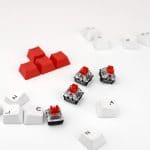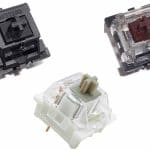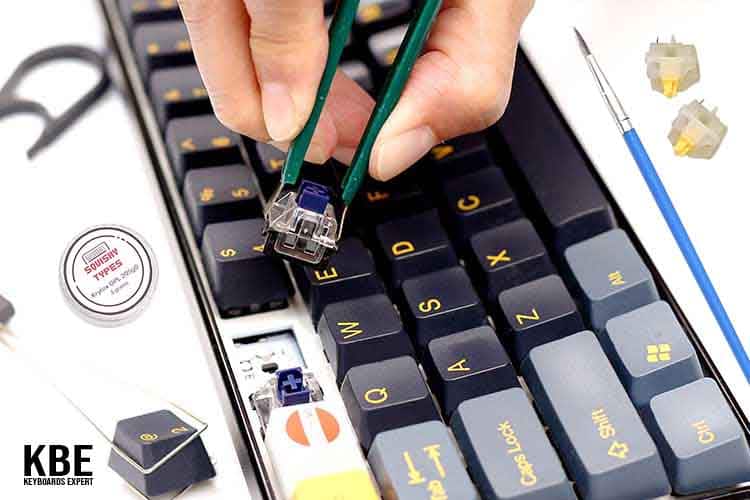
As the saying goes, “less is more.” The same philosophy applies to lubing switches as well. In TaehaTypes’ popular lubing guide video, he makes sure to mention this. But what happens when you follow the opposite?
Over lubing switches is, to say the least, an interesting experience. While the goal of lubing switches is to provide an improved typing experience, over lubing a switch causes quite the opposite. This article aims to shed light on a faux pas in the keyboard hobby.
In this article, we’ll go through how to tell whether you’ve over-lubed your switches. We will provide instructions on fixing over-lubed switches if you accidentally put too much lube on them. By the end of this article, you’ll know how much lube to use on your switches to get the right feel and sound.
Brief Introduction To Switch Lubing
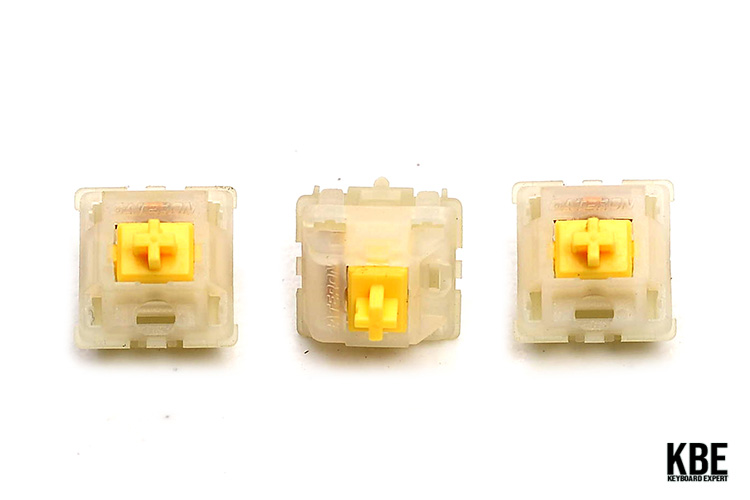
Switch lubing is an almost essential component of keyboard modding. It is intended to bring the best out of a switch, ergo, the best out of a keyboard—better sound, smoother keypress, and minimizing ping. While the process takes quite a while, It isn’t wrong to say it will be worth the effort. If you want to read more into switch lubing, head on to our in-depth switch lubing and filming article once you are done here.
What Happens When You Over Lube Switches?
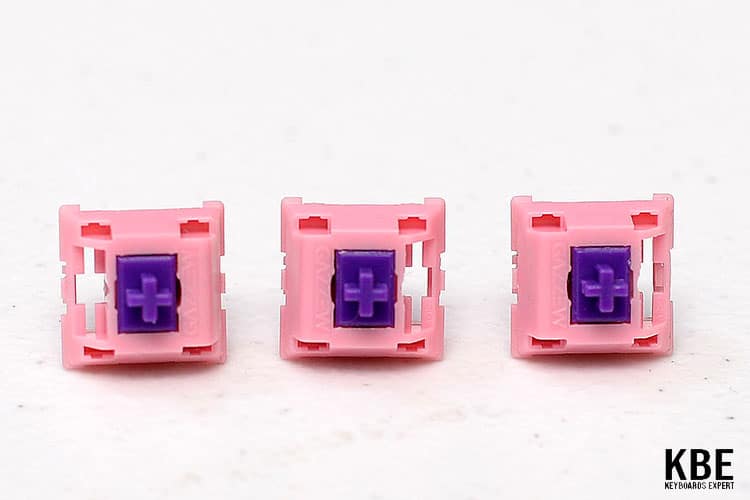
Many lubricating guides will tell you to use only a bead of lubricant per side when applying, spreading the lube with a brush until the white grease color is barely visible. Over lubed switches will have very, very visible traces of lubricant.
Extreme cases may have whole beads of lubricant still visible even after spreading the lube.
The tell-tale sign that you have an over-lubed switch is a massively different feel and sound. Excessive lubing may even lead to non-functioning or malfunctioning switches. This can happen when excess lube blocks the spring action or the metal contacts are blocked, rendering the switch unusable/less-than-usable. This is more likely to occur with thicker grease types of lube.
How To Tell If Your Switches Are Over-Lubed?
Pressing down on an over-lubed switch feels massively different from a lubed switch, more so from an unlubed switch. An over-lubed switch will feel sluggish and slow – totally opposite from the intended target of smooth and snappy travel.
Linear switches will turn into silent versions of the switch. Linear switches are known for smooth operation and snappy sound. Over lubed linears are the polar opposite, and they will feel mushy and sound very quiet.
Tactile switches are the easiest to check for over-lubing. A tactile switch can be over-lubed by over-application of lube on the legs. This is because the legs on a tactile switch stem give it its tactility, and the switch may end up feeling like a linear switch.
When lubing clicky switches, it is advised to lubricate, at most, the springs and barely touch the stem. A clicky switch is considered over lubed when the clicking mechanism is greatly affected. The clicky switch is now akin to a light tactile or a linear with unusual travel.
It is worth noting that there needs to be quite a lot of lube involved for all of this to happen. Way more than “generous” lube applications.
What To Do If You Over Lube Your Switches?
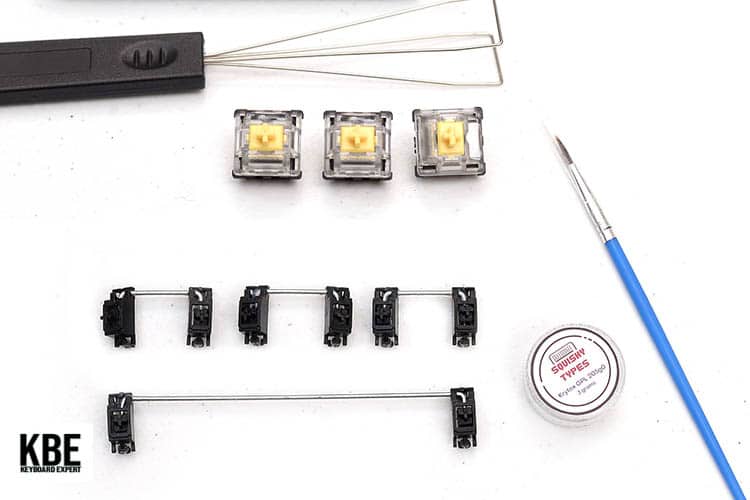
The most sensible answer would be to clean your switches. There are a few preferred methods to clean over lubed switches. This also applies to removing factory lube with an unsatisfactory application. It is better to start this with your switches disassembled.
Wiping the Switch Clean
- Fairly easy to understand, this process involves giving the lubricated switch a wipe down, going through every part meticulously with a piece of cloth or tissue.
- This process will take quite a bit of time, especially if there is a lot of excess lubricants. There is also no guarantee that the switches will come out free of lubricant, as the grease may just be transferred/distributed throughout the switch.
Q-tips/Cotton Swabs with Alcohol
- A more precise cleaning method compared to the previous one. This involves using alcohol to help dissolve any excess lubricant, and the swab also offers more thorough cleaning.
- Do not apply too much alcohol as excessive contact with alcohol may damage certain plastics. It can cause discoloration and deformation, ruining your switch.
- You can clean Springs using a method similar to bag lubing but with alcohol instead. Feel free to be generous with the alcohol as springs are generally metallic.
- You may want to run through your switches again with a dry cotton swab before beginning air drying to make sure there is barely any remnant of alcohol solution.
Soap and Water
- If you’ve ever experienced washing keycaps, the process is similar, albeit with more sensitive components and not pure plastic.
- This process is much easier when done by batches according to component (grouped by stems, housings, springs)
- Simply wash the components with soapy water, occasionally passing through each component with a small cleaning brush/old toothbrush.
- Do note that the bottom housing has metal contact so exercise extreme caution when cleaning this part with this method.
Sonic Washer
- Using an ultrasonic cleaner may be overkill for cleaning switches, but it will get the job done.
- It would be safe to assume that having a sonic washer means you are familiar with using it. There isn’t anything different to cleaning switches with a sonic washer compared to other things.
- Since lubes is grease or oil, you may need a degreaser for your washing solution to get the best results. You might also need to give the switches a rinse with water before drying.
Verdict/Summary
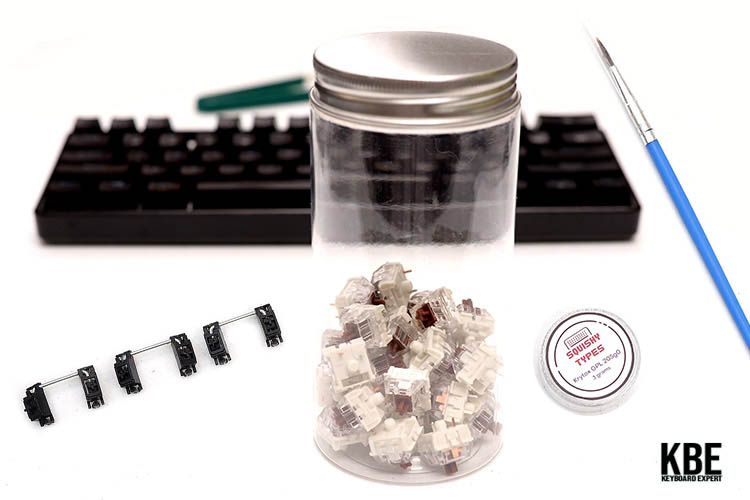
Lubing by hand takes quite some time, and when fatigue sets in, mistakes tend to happen. Although it’s very easy to minimize lube usage, there may come a time when you end up using more lube than expected. Perhaps you may have picked up quite a lot of lube with your brush and decided that instead of putting the excess back into your container, it was a better idea to apply it onto the switch.
Maybe you were following Gazzew’s lubing method but out of curiosity, tried it at every contact point. Whatever the case, refining your technique is all part of the learning experience.
